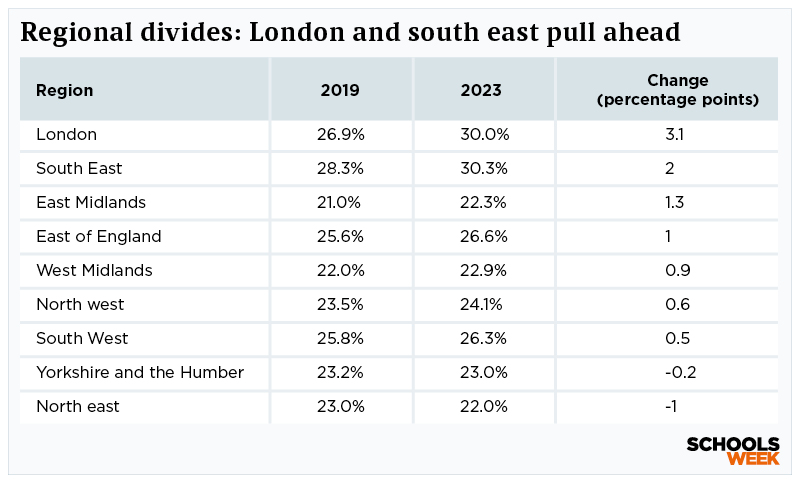The widening regional attainment gap between north and south is “uncomfortable” but shows a “picture that needs to be seen”, Ofqual’s chief regulator said.
Dr Jo Saxton told Schools Week how this year’s results “hold up a mirror” for ministers as grades return to pre-pandemic levels.
A widening gap between London and the south east and the rest of the country was exposed in today’s results, with the north east hardest-hit.
Saxton said resolving this was “for policy makers” as her job has been focused on “making sure that the rules were the same for everyone in exams and that wherever somebody was in the country, they were being assessed in the same way”.
“That’s what has happened this summer. These results hold up a mirror. Some of the things that they show are uncomfortable – absolutely – but it’s a picture that needs to be seen.”
The Department for Education today admitted that “there’s more to do” to raise standards.
DfE focusing on attainment gap
The north east now has the lowest proportion of A* or A grades (22 per cent).
It has been surpassed by both the east and West Midlands, whose top grades rose to 22.3 per cent and 22.9 per cent respectively.
However, compared to 2019, London and the south east have recorded the biggest rises.
It means the gap between the two top-performing regions and the rest of the country has widened.

Nick Gibb, schools minister, told the BBC that performance outside London and the south east was “broadly similar” – and pointed to the east and West Midlands, where 22.3 and 22.9 per cent of grades were A*s and As respectively.
However, the data shows that the north east was 2.2 percentage points ahead of the east Midlands and 1.2 ahead of the West Midlands in 2019, but now lags behind.
“The issue in the north east is they have a higher proportion of children from disadvantaged backgrounds, and that is reflected in the results. And again the focus of this government is closing that attainment gap.”
The attainment gap that Gibb referred to widened to its largest size in 10 years last year, and had already started widening before the pandemic.
Two-year grading plan ‘delivered’
Saxon, a former academy trust leader, also confirmed exams will be back to normal next year – so without grading protection, to ensure results did not fall below those in 2019.
DfE is yet to confirm the plan with exam aids, but it is expected they won’t be used, Gibb said earlier this month.
It marks the end of a two-year plan to remove pandemic inflation.
Returning back to pre-pandemic standards means “people know what that benchmark is and what students need to know, understand and do to achieve a certain grade,” Saxton said.
Asked whether it was fair to have no protections next year, she said while the pandemic has “cast a long shadow” it is “further and further in the past”.
School leaders are “very conscious” about the effects of the pandemic but students have been in school “much more consistently than they have since 2020”.
“We’ve been really clear that this was a part of a two-year plan and that two-year plan is now delivered.”
However, given the lockdown learning loss – for instance maths attainment is still way below pre-pandemic – this means results could fall again for pupils next year.
The DfE said it was “fairer” for all pupils to return to normal exams and grading.
Saxton added she was “really emotional” about 79 per cent of students achieving their first choice of university, adding: “These grades should unlock opportunity and that is clearly happening.”
On the regional divides, DfE said it is investing in 55 education investment areas – about half located in the north – “where we are implementing a package of measures to drive school improvement and improve pupil outcomes”.
They added “there’s more to do to continue raising standards and ensure pupils in state schools – regardless of where they are in the country – have the same opportunities as their peers”.
















Perhaps my recent blog on BERA. might answer some of the regional variation? https://www.bera.ac.uk/blog/the-grass-ceiling-contextualising-english-rural-urban-educational-outcomes
[…] disadvantaged students in North East England schools. The Chief Regulator of Ofqual, Dr Jo Saxton, told Schools Week that the widening regional attainment gap between the North and South is […]